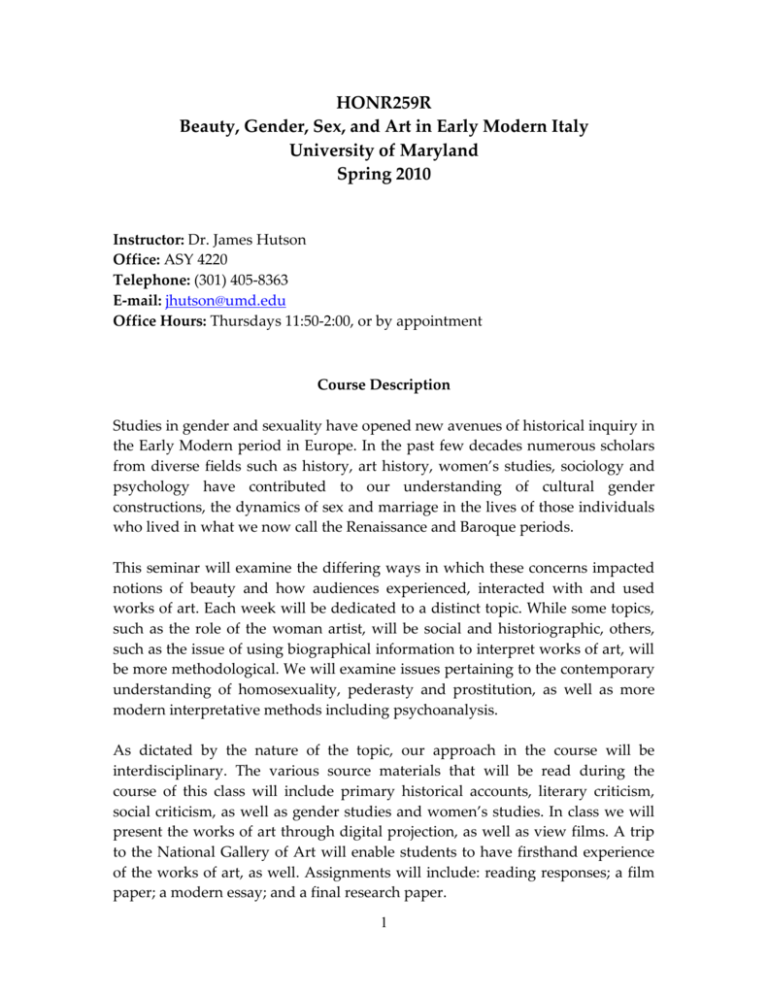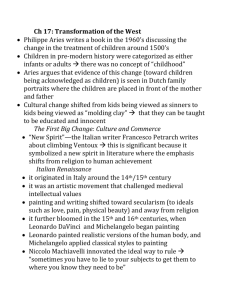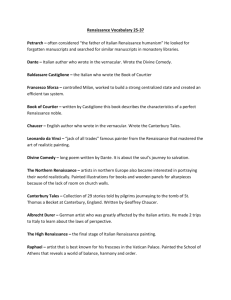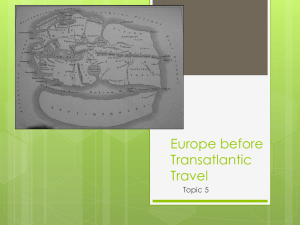
HONR259R
Beauty, Gender, Sex, and Art in Early Modern Italy
University of Maryland
Spring 2010
Instructor: Dr. James Hutson
Office: ASY 4220
Telephone: (301) 405-8363
E-mail: jhutson@umd.edu
Office Hours: Thursdays 11:50-2:00, or by appointment
Course Description
Studies in gender and sexuality have opened new avenues of historical inquiry in
the Early Modern period in Europe. In the past few decades numerous scholars
from diverse fields such as history, art history, women’s studies, sociology and
psychology have contributed to our understanding of cultural gender
constructions, the dynamics of sex and marriage in the lives of those individuals
who lived in what we now call the Renaissance and Baroque periods.
This seminar will examine the differing ways in which these concerns impacted
notions of beauty and how audiences experienced, interacted with and used
works of art. Each week will be dedicated to a distinct topic. While some topics,
such as the role of the woman artist, will be social and historiographic, others,
such as the issue of using biographical information to interpret works of art, will
be more methodological. We will examine issues pertaining to the contemporary
understanding of homosexuality, pederasty and prostitution, as well as more
modern interpretative methods including psychoanalysis.
As dictated by the nature of the topic, our approach in the course will be
interdisciplinary. The various source materials that will be read during the
course of this class will include primary historical accounts, literary criticism,
social criticism, as well as gender studies and women’s studies. In class we will
present the works of art through digital projection, as well as view films. A trip
to the National Gallery of Art will enable students to have firsthand experience
of the works of art, as well. Assignments will include: reading responses; a film
paper; a modern essay; and a final research paper.
1
Course Goals
Through readings in primary and secondary sources, a knowledge of the major
personalities and issues associated with gender and sexuality shall be gained
from the Early Renaissance to the Late Baroque. Special attention will be paid to
the notion of artistic creation and the role of the woman artist, as well as the
education of the artist. Also, through group presentations students will
demonstrate their abilities to condense and communicate readings to their peers,
preparing them for seminars.
CORE Distributive Studies, History or Theory of the Arts [HA]
and CORE Human Cultural Diversity [D]
Grading System
Course Evaluation:
1. Comparison Essay (due March 23) (15%)
2. Research Paper (due May 13) (35%)
3. Final Exam (20%)
4. Presentations/ Group Discussions (20%)
5. Class Participation (10%)
Grading for this course is based 70% on exams and 30% on other factors.
Explanation of Grading Standards:
A (90%-100%) = goes beyond basic requirements of assignment, excellent
understanding of the topic/question, an insightful and thoughtful response to the
material covered, persuasive and logical argumentation, and no typographical or
grammatical errors
B (80%-89%)= completes requirements of assignment efficiently, demonstrates
competent understanding of the topic/question, adequate grasp of information,
logical argument, possibly a few organizational problems or grammatical errors,
but shows overall coherence in discussion and has few or no problems with
grammar or typing
C (70%-79%)= meets minimum requirements of the assignment but reveals
superficial preparation through problems with factual information (omissions or
errors) and logical argument, and may have grammatical and/or typographical
errors
D (60%-69%)= inadequate work, does not follow directions, poor use of
resources, serious writing problems
F (0%-59%) = work not turned in or does not match assignment requirements
2
Required Texts (Reserve /Art Library):
Paola Tinagli, Women in Italian Renaissance Art: Gender, Representation, Identity
(Manchester University Press: New York, 1997).
Stacks | ND1460.W65 T56 1997
Laurie Schneider Adams, Art and Psychoanalysis (Icon Editions: New York, 1993).
Stacks | N72.P74 A32 1993
Recommended:
Sylvan Barnet, A Short Guide to Writing About Art (Prentice Hall, 2008).
Additional Readings on Reserve/ Art Library:
Anne Sutherland Harris, Seventeenth-Century Art and Architecture, 2nd ed. (Pearson
Prentice Hall: Upper Saddle River, N.J., 2009). Folio | N6756 .H33 2008
Laurie Schneider Adams, Italian Renaissance Art, (Westview Press.: Boulder,
Colorado, 2001). Folio | N6915 .A323 2001
Frederick Hartt & David G. Wilkins, History of Italian Renaissance Art, 6th ed.
(Prentice Hall: New Jersey, 2006). Folio | N6915 .H37 2006
Academic Integrity Code:
It is expected that students will conform to all regulations of the university, and
of the classes in which they are registered. All class members are to follow the
fundamental principles of academic integrity outlined in the Code of Student
Rights, Responsibilities, and Conduct. The Policy on Academic Misconduct
appears in the Code and in the Schedule of Classes. The basic principle is that
students take credit only for the ideas and efforts that are their own. Any act of
academic dishonesty will place you in jeopardy of the most severe form of
sanction by Towson University - expulsion from the University.
Included among dishonest behaviors in an academic setting are cheating (using
or attempting to use unauthorized assistance, materials, information, or study
aids in an academic exercise), fabrication (falsifying or inventing information in
an academic exercise), plagiarism (adopting or reproducing of ideas, words, or
statements of another person without appropriate acknowledgment),
interference (stealing, changing, destroying, or impeding another student's
work), and facilitating (intentionally or knowingly helping or attempting to help
another student commit an act of academic misconduct).
http://wwwnew.towson.edu/provost/resources/studentacademic.asp
3
Research Paper:
For this course you will be expected to produce a 9-11 page research paper using
no less than five scholarly sources. The topic for the paper can be chosen from a
list of suggested topics to be presented in due course or an outside topic to be
presented to me for approval. Chicago Manual Style should be used to format
the paper and its contents. There will be no extensions granted for the paper and
a deduction of 5 points will be assessed for every day (including weekends) that
the paper is late.
Late Papers:
In addition to the previously stated requirements, all late papers must be turned
in to either the instructor or their mailbox in printed form. Electronic
submissions will only be accepted with the instructor’s permission.
Group Presentations:
Every class there will be one (or more ) reading(s) that the entire class will be
responsible for and another set that will be presented by a pre-selected group.
During your group’s presentation you will be responsible for presenting a
summation of the content of the readings to the rest of the class and answering
any questions that might arise.
The Writing Center
The writing center provides opportunities for undergraduates to improve their
writing skills. Trained tutors are available to assist you through all the stages of
the writing process. Writers of all levels can benefit from the training available at
the Writing Center (0125 Taliaferro Hall; (301) 405-3785).
Extra-Credit Assignments
There will be no extra-credit assignments for the course. If you attend all of the
class meetings, do the accompanying readings in the text, and take thorough
notes, then you will have no difficulty excelling.
Attendance Policy:
If you are going to miss class, please copy someone’s notes who will attend the
class. Students will be excused for an absence due only to illness (self or
dependent), religious observances, participation in university activities at the
request of university authorities, and compelling circumstances beyond the
student’s control. As a portion of your grade is based on class participation,
repeated absences will adversely affect your grade. Official closures and delays
in the university’s operating hours are announced on the campus website
4
(http://www.umd.edu/) and the snow phone line (301-405-SNOW) as well as
local radio and TV stations.
Accommodations for Students with Disabilities
Appropriate accommodations will be provided for students with documented
disabilities. In order to ascertain what accommodations may be needed, please
bring them to my attention as early as possible. If alternative measures are
required for testing, they must be brought to my attention two weeks prior to
each examination. You may also contact the disability office at dissup@umd.edu,
or (301) 314-7682.
Blackboard
This web-based course system gives access to an online copy of the syllabus,
assignments and other related materials. To reach the Blackboard site, go to
www.elms.umd.edu, which will give you the log-in page. Log in with your UMD
Directory ID and password.
Extra-Credit Assignments
There will be no extra-credit assignments for the course. If you attend all of the
class meetings, do the accompanying readings in the text, and take thorough
notes, then you will have no difficulty excelling.
Cell Phones and Electronic Devices:
Please turn off all cell phones and PDAs during class time as they are a
distraction. Additionally, during exams these devices are assumed to be used for
academic dishonesty. Be sure to put them away!
Web Resources
- Researching and Writing About Art and Artists: History, Theory and
Criticism
http://www.lib.umd.edu/guides/artartist.html
- Visual Image Resources on the Web
http://www.lib.umd.edu/guides/artimagesweb.html
- Visual Image Resources in Print
http://www.lib.umd.edu/guides/artimagesprint.html
5
- Web Resources for Art, Art History and Archaeology
http://www.lib.umd.edu/guides/artinternet.html
- Research Resources for Art, Art History and Archaeology
http://www.lib.umd.edu/ART/artresources.html
- Browser's Guide to the Art Library
http://www.lib.umd.edu/guides/artbrowse.html
Art History and Archaeology Department Webpage
http://www.arthistory-archaeology.umd.edu/
Museums
Washington D.C. Museums. A Ross Guide is an excellent source of information that
is available at bookstores. Current exhibitions are also listed in the Friday edition
of the Washington Post called the Weekend Section.
Museums on the Mall
The National Gallery of Art, West Wing (pre-20th century) and East Wing (20th
century) and Garden between 7th and 4th on Constitution Ave. NW (north
side of the Mall)
The National Museum of African Art, 950 Independence Ave. SW
The Sackler and Freer Museums of Asian Art, 950 Independence Ave. SW
The Hirshorn Museum and Sculpture Garden, 8th and Independence SW
(modernist and contemporary painting, sculpture, and installation art)
Surrounding Museums
The Art Museum of the Americas, 201 Eighteenth Street NW
The B’nai Brith Klutznick Museum, 1640 Rhode Island Ave. NW (Jewish Art)
The Corcoran Gallery, 17th Street and New York Ave. NW (American and
European Art, contemporary art; facsimiles of the Parthenon frieze
sculptures are exhibited around the central court area on the main floor)
Dumbarton Oaks Collection and Gardens, 1703 32nd Street NW (Georgetown)
(Byzantine and Pre-Columbian Art)
The Smithsonian American Art Museum and the National Portrait Gallery, 8th
and G NW
6
The National Museum of Women in the Arts, New York Ave. NW and 13th St.
The Phillips Collection, 1600 21st Street NW (21st and Q) (Impressionism and
modernism)
The Renwick Gallery, 17th Street and Pennsylvania Ave. NW (American art and
fine crafts)
The Mary McLeod Bethune Museum-Archives, 1318 Vermont Ave. NW (AfricanAmerican art)
Jane Turner ed. The Grove Dictionary of Art (New York: St. Martin’s Press, 2000).
Art Library Stacks N6946 .G76 2000
Lecture Schedule: Th 2:00-4:30
Week One
1/28
Introduction: What was/ is Beauty?
Timeline—Geography—Arti di disegni
Hartt: pp.17-36; Adams: pp.2-9.
__________________________________________________________________
Week Two
2/4
Difference in Gender & Sex: Biology & Social Constructions
Lecture: Precursors to the Renaissance & Early Renaissance I
Giotto (ca.1267-1337); Duccio (ca.1255-1260-ca.1319)
Hartt: pp.39-264; Adams: pp.9-141.
Class Reading(s): Tinagli, “Introduction,” Women in Italian Renaissance
Art, pp.1-20.
Group 1 Reading(s): Hemsoll, “Beauty as an aesthetic and artistic ideal in
late fifteenth-century Florence,” Concepts of Beauty in Renaissance Art,
pp.66-79.
__________________________________________________________________
Week Three
2/11
College Art Association Conference (no class)
Week Four
2/18
Beauty & the Power of Representation
7
Lecture: Early Renaissance II
Botticelli (ca.1445-1510); Prosperzia De’Rossi (1490-1530)
Hartt: pp.265-444; Adams: pp.142-291.
Class Reading(s): Tinagli, “Women, Men and Society: Painted Marriage
Furniture,” Women in Italian Renaissance Art, pp.21-46.
Group 2 Reading(s): Tinagli, “Profile portraits in the Quattrocento: virtue
and status,” Women in Italian Renaissance Art, pp.47-83.
Week Five
2/25
Leonardo, Freud & Homosexuality: Psychoanalysis & Art
Lecture: High Renaissance I
Leonardo da Vinci (1452-1519)
Hartt: pp.445-469; Adams: pp.292-311.
Class Reading(s): Adams, “Beginnings,” & “Freud’s Leonardo: The
Controversy,” Art and Psychoanalysis, pp.1-14; 14-40.
Group 3 Reading(s): Rocke, “Introduction: Florence and Sodomy,”
Forbidden Friendships, pp.3-18.
Rogers, “The Artist as Beauty,” Concepts of Beauty in Renaissance Art, pp.93106.
Week Six
3/4
Raphael: the Idea of Beauty
Lecture: High Renaissance II
Raphael (1483-1520)
Hartt: pp.479-483, 521-548; Adams: pp.321-356.
Class Reading(s): Tinagli, “Portraits 1480-1560: beauty and power,”
Women in Italian Renaissance Art, pp.84-120.
Group 4 Reading(s): Mansfield, “Myth and Mimesis in the Renaissance,”
Too Beautiful to Picture, pp.39-53.
Week Seven
3/11
Michelangelo: The “divine” artist & Platonic Love
Lecture: High Renaissance III
Michelangelo (1475-1564)
8
Hartt: pp.469-479, 503-521, 549-561, 657-667; Adams: pp.312-321, 379-392.
Class Reading(s): Adams, “Michelangelo’s Moses and Other
Michelangelo Problems,” Art and Psychoanalysis, pp.155-175.
Group 1 Reading(s): Rocke, “’He keeps Him like a Woman’: Age and
Gender in Social Organization of Sodomy,” Forbidden Friendships, pp.87111.
Snow-Smith, “Michelangelo’s Christian Neoplatonic aesthetic of beauty,”
Concepts of Beauty in Renaissance Art, pp.147-162.
Visit NGA over Spring Break
Week Eight
Spring Break- no class (3/15-3/22)
Week Nine
3/25
Titian: Venetian Courtesans & the Nude
Lecture: Venetian High Renaissance
Titian (ca.1490-1576)
Hartt: pp.599-656; Adams: pp.357-378.
Class Reading(s): Tinagli, “Female nudes in Renaissance art,” Women in
Italian Renaissance Art, pp.121-154.
Group 2 Reading(s): Castiglione, “Third Book” (on the Court Lady), The
Book of the Courtier, pp.161-228.
Cropper, “On Beautiful Women: Parmigianino, Petrarchismo, and the
Vernacular Style.” Art Bulletin 58 no.3 (September 1976): 374-394.
Comparison Papers due
Week Ten
4/1
Sofonisba: The “Problem” of the Woman Artist
Lecture: Mannerism I
Sofonisba Anguissola (1532-1625)
Hartt: pp.561-598; Adams: pp.392-399.
Class Reading(s): Nochlin, “Why Have There Been No Great Women
Artists?” (1971), in Women, Art, and Power and Other Essays (New York,
1988), pp.145-178 (N72.F45 N64 1988)
Group 3 Reading(s): Garrard, “Here’s Looking at Me: Sofonisba
Anguissola and the Problem of the Woman Artist,” Renaissance Quarterly
47 (1994), pp.556-622 (on JSTOR)
9
Week Eleven
4/8
Cellini: The Codification of Arts Education
Lecture: Mannerism II
Benvenuto Cellini (1500-1571); Lavinia Fontana (1552-1614)
Hartt: 657-691.
Class Reading(s): Levy, “Ideal and Reality of the Learned Artist: The
Schooling of Italian and Netherlandish Artists.” In Children of Mercury: the
education of artists in the sixteenth and seventeenth centuries, pp.20-28.
Bleek-Bryne, “The Education of the Painter in the Workshop.” In Children
of Mercury: the education of artists in the sixteenth and seventeenth centuries,
pp.28-39.
Group 4 Reading(s): Gallucci, Benvenuto Cellini: Sexuality, Masculinity, and
Artistic Identity in Renaissance Italy, pp.1-44
Week Twelve
4/15
Caravaggio: “Homo-Erotic” Works & Reception Theory
Lecture: Early Baroque I
Caravaggio (1571-1610)
Harris: pp.viii-xxiii, 1-6, 33-49.
Class Reading(s): Adams, “Psychobiography: Caravaggio, Artemisia,
Brancusi,” Art and Psychoanalysis, pp.291-303.
Group 1 Reading(s): Posner, "Caravaggio's Homo-erotic Early Works,"
Art Quarterly 34 (1975), 301-24.
Trinchieri Camiz, “Music and Painting in Cardinal del Monte’s
household,” Metropolitan Museum Journal 26 (1991), pp.213-226
Week Thirteen
4/22
Guido Reni: Witchcraft & Misogyny
Lecture: High Baroque I
Class Reading(s): Levack, “The Witch,” in Baroque Personae, Rosario
Villari ed. (Chicago: University of Chicago Press, 1995), pp.239-262.
Group 2 Reading(s): Wiesner ed. “Gender and Witchcraft” & “The
Malleus Maleficarum and the Construction of Witchcraft: Theology and
Popular Belief,” Witchcraft in Early Modern Europe, pp.149-162.
Spear, “Witches,” The “Divine” Guido: Religion, Sex, Money and Art in the
World of Guido Reni, pp.44-50
10
Week Fourteen
4/29
Artemisia: Rape & Sexual Politics:
Biographical Interpretations
Lecture: High Baroque II
Artemisia Gentileschi (1593-ca.1652)
Harris: pp.50-55.
Class Reading(s): Adams, “Psychobiography: Caravaggio, Artemisia,
Brancusi,” Art and Psychoanalysis, pp.303-311.
Group 3 Reading(s): Mary D. Garrard, “Artemisia and Susanna,” Norma
Broude and Mary D. Garrard eds., Feminism and Art History: Questioning
the Litany, 146-171. N72.F45 F44 1982
Patrizia Cavazzini, “Artemisia in Her Father’s House,” in Italian Baroque
Art, Susan M. Dixon, ed. (Blackwell: Oxford, 2008), pp.98-112
Week Fifteen
5/6
The “Theory of Everything”:
the Patriarchal Structure of the Universe
Lecture: High & Late Baroque
Gianlorenzo Bernini (1598-1680)
Harris: pp.85-142.
Class Reading(s): Filipczak, ed. “A Little World Made Cunningly of
Elements,” Hot Dry Men Cold Wet Women: The Theory of Humors in Western
European Art 1575-1700 ex. cat. (New York: The American Federation of
Arts, 1997), pp.14-27.
(No Group Reading)
Week Sixteen
5/13
Final Exam (TBA)
Research Papers due
11









